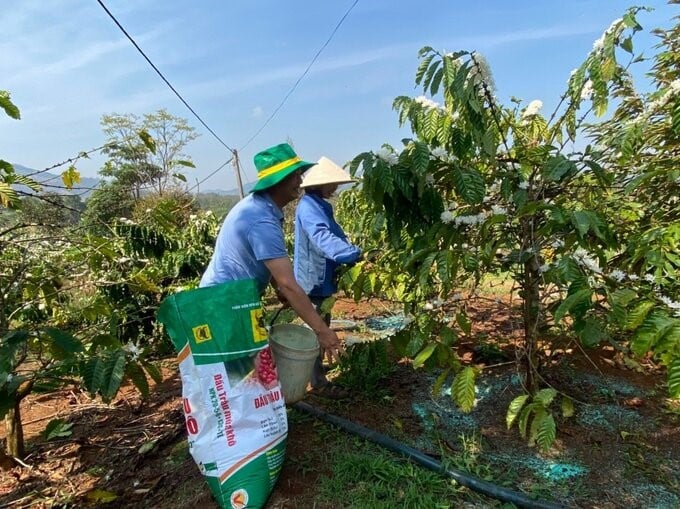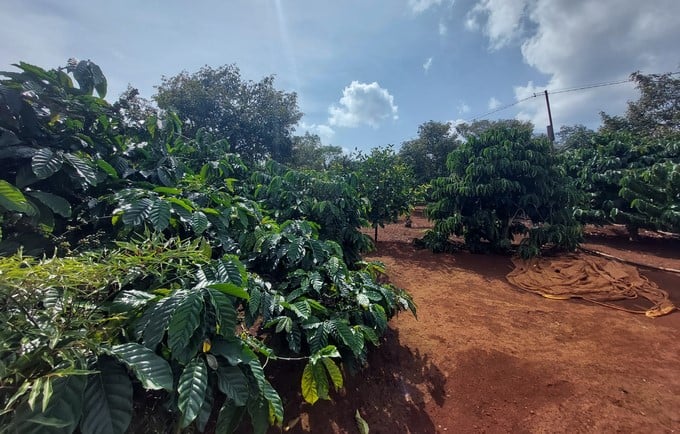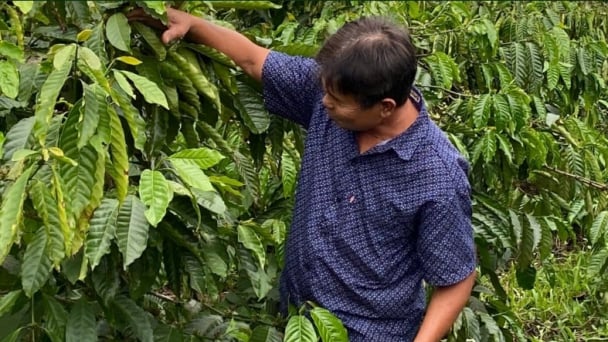June 21, 2025 | 01:59 GMT +7
June 21, 2025 | 01:59 GMT +7
Hotline: 0913.378.918
June 21, 2025 | 01:59 GMT +7
Hotline: 0913.378.918

The areas of replanted coffee, combined with the application of organic, ecological, and sustainable production processes, are bringing remarkable results. Photo: Minh Quy.
The National Institute of Agricultural Planning and Projection (NIAPP) and the Department of Crop Production (Ministry of Agriculture and Rural Development), in collaboration with the Central Highlands provinces, have just organized a workshop on developing the project "Development of key industrial crops by 2030".
The workshop aimed to collect comments from managers, scientists, experts, and enterprises in the production, processing, and export of agro-products to complete the report "The current situation and development orientation of rubber, coffee, pepper, and cashew trees by 2030".
Vietnam's coffee area in 2022 reached 709,000 ha, an increase of 1.21 times compared to 2012. The average growth rate in the 2011–2022 period reached over 2%/year. The average productivity of the whole country in 2022 reached 29 quintals/ha, an increase of 1.24 times compared to 2011. The output increased from 1.277 million tons in 2011 to 1.886 million tons in 2022.
According to Mr. Le Ba Hoai, an expert from NIAPP, the area of over-15-year coffee in the Central Highlands is currently over 132,000 ha, accounting for over 50% of the region's area. Of which, Dak Lak has the largest percentage of old and stunted, low-yielding coffee gardens in the country, with over 27% of old and stunted arabica coffee areas.

The abuse of chemical fertilizers in coffee production in the Central Highlands is causing the production of this commodity to lack sustainability. Photo: MQ.
Coffee now is one of the industrial crops with high economic value, significantly contributing to people's income as well as Vietnam's export turnover. However, Vietnamese coffee products still have many shortcomings, such as: mostly raw processing; a small proportion of deep-processed and refined products; weak linkage and development cooperation according to value chain; geographical indications, trademark development and protection, and international intellectual property for coffee products have not been focused on; the application of 4.0 technology in production is still facing many difficulties; and the coffee industry is facing competition from many countries, such as Brazil, Laos, West African and East African countries, etc.

Currently, Vietnamese coffee only focuses on raw processing without specialized products. Photo: Minh Quy.
The current situation of coffee development is fragmented, spontaneous, and unplanned, with low investment, low quality, and poor cleanliness. Besides, due to the small orchard scale, it is very difficult to apply technical measures of intensive farming, plant protection, and product collection according to modern technology.
The tendency to over-exploit orchards by abusing chemical fertilizers, growth stimulants, and pesticides in an overdose to have immediate yield and output, but then the orchards quickly fade away, causing low and unstable economic efficiency.
The situation of spontaneously buying, selling, pledging, and transferring orchard land, burning and destroying coffee and rubber-growing forests has become popular. It has been threatening the sustainable development of many perennial industrial orchards, greatly affecting the environment, irrigation water sources, and ecology. Besides, production has not been associated with processing or consumption. Most of Vietnam’s perennial industrial crop products have not been processed at high-level factories with modern machinery, so exported products are mainly raw or preliminary processed materials with weak competitiveness in quality and price.
Currently, thanks to export tariff preferences for processed coffee, many businesses have begun to pay attention and focus on investing in this field. Since then, businesses have contributed to increasing the added value of products and the export turnover of the whole industry. Coffee is one of 39 geographical indications in Vietnam committed to protection by the EU. This is the competitive advantage of Vietnamese coffee over competitors in the EU market.
According to Ms. Cao Phuong Nhung from NIAPP, Vietnam’s coffee area in 2022 reached 709,000 ha, an increase of 1.42 times compared to the approved plan in 2018. This has disrupted the planning and greatly affected the productivity, quality, and value of Vietnamese coffee.
Therefore, in the period up to 2030, Vietnam will not expand new planting areas but only develop areas with particularly suitable natural and socio-economic conditions on the basis of renovating existing coffee gardens and replanting coffee in old and stunted, low-yield areas.

Vietnam needs to focus on replanting old and stunted coffee gardens instead of expanding the area in the near future. Photo: Minh Quy.
In order to contribute to the development of Vietnam's coffee industry, all levels and sectors have had many supporting mechanisms and policies, especially the socio-economic development strategy for the ten-year period of 2021–2030.
Specifically, the supporting policies include support for tax incentives, land leases, and crop restructuring; supporting varieties, replanting, fertilizers, and production according to standards; encouraging cooperation development and linkage to produce and consume coffee products; digital transformation in agriculture; supporting the integration of coffee development with other types of tourism; and supporting the establishment and protection of enterprises’ intellectual property in export markets.
According to NIAPP, the common goal of Vietnam's coffee industry is to review and adjust the coffee growing area reasonably, shaping the scale from 660,000 to 690,000 ha by 2025 and from 610,000 to 640,000 ha by 2030.

Vietnam has many policies to encourage businesses to invest in coffee processing. Photo: Minh Quy.
Authorities and businesses will increase investment, build and upgrade processing factories, and renew technological lines to improve quality and diversify products, thereby meeting the increasing requirements of the export market. The activities of improving quality, diversifying products, and effectively implementing the coffee value chain aim to maintain, expand, and increase the export value of over US$6 billion/year.
In which the agricultural sector's development orientations for coffee to 2030 include orientation in terms of scale, area, output, and added value according to territorial space in order to promote irrigation in each region; orientation on production development associated with the 4.0 technology, digital transformation, and digital economy; developing the coffee processing and preservation industry; developing logistics; developing processing and export enterprises; developing coffee associated with tourism; and using by-products and finished products to add value for industrial crops.
Mr. Bach Thanh Tuan, Vice Chairman of the Vietnam Coffee - Cocoa Association (VICOFA), said that the coffee development project should review the context and orientation to 2030 and supplement international regulations required for this industry.
Specifically, according to the current EU’s regulations, coffee products from forests that damage forests will not be imported. In particular, if the Government commits to reducing greenhouse gas emissions, the project needs to include regulations on this issue. Only then will this industry contribute to the implementation of Vietnam's commitments to the world.
Translated by Huyen Vu Thu

(VAN) The waste of resources from agricultural by-products and the situation of counterfeit and poor quality goods in production causing losses of thousands of billions were pointed out by the National Assembly deputy.

(VAN) After 5 years of implementation, the CAI initiative has helped coffee growers change their farming practices, moving toward responsible agriculture that meets global export standards.

(VAN) The primary prerequisite for the comprehensive and robust integration of Vietnam's livestock sector into the global value chain is the establishment of a disease control system.

(VAN) The results of national programs are essential for establishing a contemporary livestock sector that is well-equipped to meet the demands of both domestic and international markets, with robust biosafety standards.

(VAN) The UNESCO Global Geopark revalidation of Non nuoc Cao Bang and the transition to a two-tier administrative model are presently undergoing a pivotal moment in Cao Bang, the northernmost province of Vietnam.
/2025/06/13/5330-2-004539_953.jpg)
(VAN) Changing policy mindset and removing investment barriers are urgent requirements to open up new development space for enterprises in the agricultural sector.

(VAN) The areas include the restoration of five million hectares of marine ecosystems.